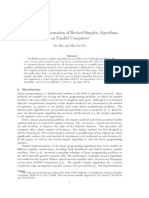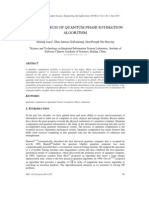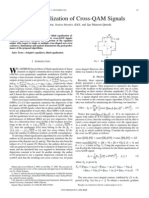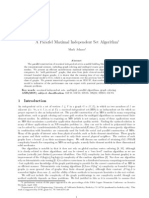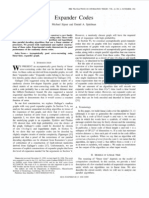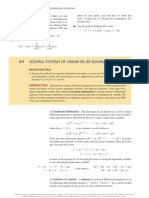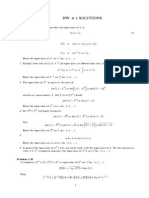Summary of EFICA
Summary of EFICA
Uploaded by
Reedip BanerjeeCopyright:
Available Formats
Summary of EFICA
Summary of EFICA
Uploaded by
Reedip BanerjeeCopyright
Available Formats
Share this document
Did you find this document useful?
Is this content inappropriate?
Copyright:
Available Formats
Summary of EFICA
Summary of EFICA
Uploaded by
Reedip BanerjeeCopyright:
Available Formats
Summary of EFICA
A basic assumption in ICA is that the elements of Original Source Signals(S),denoted by s ij, are mutually independent identically distributed random variables with probability density functions (pdfs) being defined as pi(si)j;i=1.d . The row variables sijfor all j=1N , having the same density, are thus an independent identically distributed (i.i.d.) sample of one of the independent sources denoted by . The key assumptions for the identifiability of the model (1), or solving both the Mixing Matrix (A) and Original Source (S) up to some simple ambiguities, are that all but at most one of the densities are non-Gaussian, and the unknown matrix has full rank, i.e., it has column/row rank, whichever is the maximum(Rank corresponds to the Linearly Independent seta(i.e. Either a row or a Column).Column Rank therefore would be the maximum number of Lineraly Independent Columns. A full rank would be possible if all Columns are independent, given No. of Columns> Number of rows.) < -Part of ICA Intro The basic ICA problem and its extensions and applications have been studied widely and many algorithms have been developed. One of the main differences is how the unknown probability density functions pi() of the original signals are estimated or replaced by suitable nonlinearities in the ICA contrast functions. NonGaussianity is the key property. For instance, JADE [SELF] is based on the estimation of kurtosis via cumulants, NPICA [SELF] uses a nonparametric model of the density functions, and RADICAL [SELF] uses an approximation of the entropy of the densities based on order statistics. The FastICA algorithm uses either kurtosis [FastICAs Paper] or other measures of non-Gaussianity in entropy approximations in the form of suitable nonlinear functions G()<- Part of Intro.Please include the other non linearities as well here
Though ICA has been very successful in large scale practical problems, it still suffers from some issues, like the Theoretical Accuracy of the Algorithm when considering the various inputs. To Prove the general Validity that the algorithm is correct and efficient, it should reach Cramer-Rao s Lower Bound.(Need to add info about CRB here) Also write in the CRB that practically the demixing matrix is not exactly the inverse of Original Sources A and the Estimated Sources is approximation of original signals with the variance being calculated as WA-unit matrix(WA is the multiplication of Demixing and Mixing matrix, and assuming a dxd Unit matrix(same dimenstions as that of A and W)
An asymptotic performance analysis of the FastICA algorithm in is compared with the CRB for ICA [SELF] and showed that the accuracy of FastICA is very close, but not equal to, the CRB. The condition for this is that the nonlinearity G() in the FastICA contrast function is the integral of the score function of the original signals, or the negative log density
[SELF]
When the asymptotic performance achieves the CRB, the absolute accuracy is reached, which cannot be improved further. Use the SectionII.A in FastICA, as a chapter.
Use the last Paragraph for EFICA, along with the figure.(If possible, try to understand the maths of section B)
EFFICIENT FASTICA: EFICA The proposed efficient version of FastICA is based on the following observations: i) The symmetric FastICA algorithm can be run with different nonlinearity for different sources; ii) in the symmetrization step of each iteration, it is possible to introduce auxiliary constants, that can be tuned to minimize mean
square estimation error in one (say th) row of the estimated demixing matrix. These estimations can be performed in parallel for all rowsto obtain an estimate of the whole demixing matrix, that achieves the corresponding CRB, if the nonlinearities correspond to score functions of the sources; and iii) the algorithm remains to be asymptotically efficient (attaining the CRB) if the theoretically optimum auxiliary constants in the algorithm are replaced by their consistent estimates. The proposed algorithm EFICA models all independent signals as they have a generalized Gaussian (GG) distribution with appropriate parameters s. The algorithm is summarized in Fig. 1. Note that the output is not constrained, unlike symmetric FastICA, in the sense that the separated components need not have exactly zero sample correlations. In order to explain the proposed algorithm in more details, the notion of generalized symmetric FastICA is introduced, and its efficiency is studied in Section III-A. The algorithm EFICA will be presented in detail in Section III-B. A. Generalizing the Symmetric FastICA to Attain the CRB Consider now a version of the symmetric version of FastICA where two changes have been made. First, as it is not possible to attain the CRB if only one Nonlinearity g()is used, different nonlinear functions, gk(),k=1,2..d will be used for estimation of each row of W+ Second, the first step of the iteration will be followed by multiplying each row of W+ with a suitable positive number ci , i=1,2.d before the symmetric orthogonalization This will change the length (norm) of each row, which will affect the orientations of the rows after orthonormalization. The true score functions are rarely known in advance, and the generalized symmetric FastICA has only a theoretical meaning. It can be proved, however, that the asymptotic efficiency of the algorithm is maintained if the score functions and the optimum coefficients are replaced by their consistent estimates. For the consistent estimation, it is necessary to have a consistent initial estimate of the mixing or demixing matrix. The ordinary symmetric FastICA is one possible choice. Second, one needs a consistent estimate of the score functions computed from the sample distribution functions of the components. This is a widely studied task, and numerous approaches have been developed either parametric [21] or nonparametric [11], [12], [22]. Note, however, that not every score function can serve a suitable nonlinearity for use in FastICA iteration. Suitable nonlinearity must be continuous and differentiable.
B. Proposed Algorithm In this section, an algorithm, called for brevity EFICA is proposed, which combines the idea of the generalized symmetric FastICA with an adaptive choice of the function , which is based on modelling of the distribution of the independent component by GG distribution [15]. The algorithm consists of three steps Step 1) Running the Symmetric FastICA Until Convergence: The purpose of Step 1) is to quickly and reliably get preliminary estimates of the original signals. In this step, therefore, the
optional nonlinearity in the original symmetric FastICA g(s)=tanh(s) is used due to its universality, but other possibilities seem to give promising results as well, e.g., .g(s)=s/(1+s2) Also, the test for saddle points as introduced in [8] is performed to get reliable source estimates.
2) adaptive choice of different nonlinearities gk to estimate the score functions of the found sources, based on the outcome of step 1); Assume that uk is the kth estimated independent signal obtained in Step 1). In many real situations, the distributions of the signals are unimodal and symmetric. In this paper,we focus on a parametric choice of gk that works well for the class of GG distributions with parameter (Symbol:alpha) denoted as GG((Symbol:Aplha)).The score function of this function is
A problem with the score function of the distribution GG((Symbol:alpha))is that it is not continuous for (Symbol:alpha) < 1 and thus it is not a valid nonlinearity for FastICA. For these (Symbol:alpha) s the statistical efficiency cannot be achieved by the algorithm using this score function. They therefore take the Super Gaussian (Symbol:alpha) >2) and Sub Gaussian ((Symbol:alpha) <2) separately. In summary, the nonlinearity of our choice is
where m4k is the estimated fourth-order moment of the kth source signal, and ((Symbol:alpha))k is
, where v1 is approx 0.2096 and v2 is approx 0.1851 Step 3): The Refinement: a refinement or fine-tuning for each of the found source components by one-unit FastICA, using the nonlinearities found in step 2), and another fine-tuning using the optimal Ck parameters (where ck
parameters are The refinement of the initial estimate proceeds in two steps. The first step, denoted R1, is a more sophisticated implementation of the relation (15). Theoretically, it would suffice to perform (15) once, starting from the initial estimate of W. However,
better results are obtained if it is performed separately for each k as series of one unit FastICA iterations, until a convergence is achieved. In the last iteration, however, the normalization step is skipped. This method works well, if the preliminary estimates of the original signals uk from the first step (symmetric FastICA) of the proposed method lie in the right domain of attraction. It might happen, however, that some of the components are difficult to separate from some other components, and the one-unit iterations converge to a wrong component. This pathological case can be excluded by checking the condition whether the angle between the component separated by the initial solution and the one unit solution is not too big. If it happens, then the one unit solution should be replaced by the initial estimate.
You might also like
- Training Feed Forward Networks With The Marquardt AlgorithmDocument5 pagesTraining Feed Forward Networks With The Marquardt AlgorithmsamijabaNo ratings yet
- 9 Bus System DataDocument16 pages9 Bus System DataKiran Mula40% (5)
- Chapter 1Document27 pagesChapter 1Tadesse AyalewNo ratings yet
- Safe and Effective Determinant Evaluation: February 25, 1994Document16 pagesSafe and Effective Determinant Evaluation: February 25, 1994David ImmanuelNo ratings yet
- Sparse Implementation of Revised Simplex Algorithms On Parallel ComputersDocument8 pagesSparse Implementation of Revised Simplex Algorithms On Parallel ComputersKaram SalehNo ratings yet
- Blind Source Separation Using Modified Contrast Function in Fast ICA AlgorithmDocument4 pagesBlind Source Separation Using Modified Contrast Function in Fast ICA AlgorithmnaeemoNo ratings yet
- Node ReorderingDocument27 pagesNode Reorderingedi18No ratings yet
- Learning 2004 1 019Document6 pagesLearning 2004 1 019tasos_rex3139No ratings yet
- Ij N×NDocument5 pagesIj N×NLaila Azwani PanjaitanNo ratings yet
- Local Search in Smooth Convex Sets: CX Ax B A I A A A A A A O D X Ax B X CX CX O A I J Z O Opt D X X C A B P CXDocument9 pagesLocal Search in Smooth Convex Sets: CX Ax B A I A A A A A A O D X Ax B X CX CX O A I J Z O Opt D X X C A B P CXhellothapliyalNo ratings yet
- ECSE 420 - Parallel Cholesky Algorithm - ReportDocument17 pagesECSE 420 - Parallel Cholesky Algorithm - ReportpiohmNo ratings yet
- Load Balancing and Switch Scheduling: Xiangheng Liu Andrea GoldsmithDocument6 pagesLoad Balancing and Switch Scheduling: Xiangheng Liu Andrea GoldsmithNikhin Perumal ThomasNo ratings yet
- Proposed As-Samp With Application To Sparse Channel EstimationDocument6 pagesProposed As-Samp With Application To Sparse Channel EstimationSuhana SaRun.VruShanholicNo ratings yet
- Bs (It) Al Habib Group of Colleges: Assignment AlgorithmDocument5 pagesBs (It) Al Habib Group of Colleges: Assignment AlgorithmusmanaltafNo ratings yet
- Aghamohammadixxx PDFDocument6 pagesAghamohammadixxx PDFhenrydclNo ratings yet
- A Direct Nemerical Metho For Observability AnalysisDocument6 pagesA Direct Nemerical Metho For Observability AnalysiselizabethloayzaNo ratings yet
- Tracking The Progress of The Lanczos Algorithm For Large Symmetric EigenproblemsDocument21 pagesTracking The Progress of The Lanczos Algorithm For Large Symmetric Eigenproblemsjuan carlos molano toroNo ratings yet
- He Research of Quantum Phase Estimation Algorithm: Zhuang Jiayu, Zhao Junsuo, Xufanjiang, Qiaopeng& Hu HaiyingDocument6 pagesHe Research of Quantum Phase Estimation Algorithm: Zhuang Jiayu, Zhao Junsuo, Xufanjiang, Qiaopeng& Hu HaiyingBilly BryanNo ratings yet
- Blind Equalization of Cross-QAM SignalsDocument4 pagesBlind Equalization of Cross-QAM SignalsShafayat AbrarNo ratings yet
- Quantum Data-Fitting: PACS Numbers: 03.67.-A, 03.67.ac, 42.50.DvDocument6 pagesQuantum Data-Fitting: PACS Numbers: 03.67.-A, 03.67.ac, 42.50.Dvohenri100No ratings yet
- Package Fastica': R Topics DocumentedDocument8 pagesPackage Fastica': R Topics DocumentedCliqueLearn E-LearningNo ratings yet
- Franklin Note 2Document21 pagesFranklin Note 2WylieNo ratings yet
- Programming Assignment 3 PDFDocument10 pagesProgramming Assignment 3 PDFMelissa OrtegaNo ratings yet
- Log (P (Si) ) ), P (Si) : Adaptable Nonlinearity For Complex Maximization of Nongaussianity and A Fixed-Point AlgorithmDocument6 pagesLog (P (Si) ) ), P (Si) : Adaptable Nonlinearity For Complex Maximization of Nongaussianity and A Fixed-Point AlgorithmBernardMightNo ratings yet
- On The GOn The Grid Implementation of A Quantum Reactive Scattering Programrid Implementation of A Quantum Reactive Scattering ProgramDocument17 pagesOn The GOn The Grid Implementation of A Quantum Reactive Scattering Programrid Implementation of A Quantum Reactive Scattering ProgramFreeWillNo ratings yet
- An Adaptive Metropolis Algorithm: 1350 7265 # 2001 ISI/BSDocument20 pagesAn Adaptive Metropolis Algorithm: 1350 7265 # 2001 ISI/BSSandeep GogadiNo ratings yet
- Montepython: Implementing Quantum Monte Carlo Using PythonDocument17 pagesMontepython: Implementing Quantum Monte Carlo Using PythonJuan Bernardo Delgadillo GallardoNo ratings yet
- A Parallel Maximal Independent Set Algorithm: Mark AdamsDocument11 pagesA Parallel Maximal Independent Set Algorithm: Mark AdamspostscriptNo ratings yet
- 2011isse SCCDocument10 pages2011isse SCCssfofoNo ratings yet
- Approximate Linear Programming For Network Control: Column Generation and SubproblemsDocument20 pagesApproximate Linear Programming For Network Control: Column Generation and SubproblemsPervez AhmadNo ratings yet
- Package Fastica': R Topics DocumentedDocument8 pagesPackage Fastica': R Topics DocumentedSally SamehNo ratings yet
- Random Walks On Weighted Graphs, and Applications To On-Line AlgorithmsDocument43 pagesRandom Walks On Weighted Graphs, and Applications To On-Line AlgorithmsSilviuNo ratings yet
- Lab # 8 SolvedDocument10 pagesLab # 8 SolvedZabeehullahmiakhailNo ratings yet
- Viterbi DecodingDocument4 pagesViterbi DecodingGaurav NavalNo ratings yet
- Power Flow Analysis of Unbalanced Multiphase Radial Distribution SystemsDocument11 pagesPower Flow Analysis of Unbalanced Multiphase Radial Distribution SystemsneripereiraNo ratings yet
- MATLAB - Transfer Functions - PrattWikiDocument4 pagesMATLAB - Transfer Functions - PrattWikiSaid EliasNo ratings yet
- Calibration Using GaDocument6 pagesCalibration Using GaDinesh KumarNo ratings yet
- Lab2 EE422Document9 pagesLab2 EE422Jose Nathaniel BonaNo ratings yet
- Steven L. Mielke Et Al - Extrapolation and Perturbation Schemes For Accelerating The Convergence of Quantum Mechanical Free Energy Calculations Via The Fourier Path-Integral Monte Carlo MethodDocument25 pagesSteven L. Mielke Et Al - Extrapolation and Perturbation Schemes For Accelerating The Convergence of Quantum Mechanical Free Energy Calculations Via The Fourier Path-Integral Monte Carlo MethodWippetsxzNo ratings yet
- Which Graph States Are Useful For Quantum Information Processing?Document13 pagesWhich Graph States Are Useful For Quantum Information Processing?essper61No ratings yet
- TR (Zak) : Xo+z,' Z + ZDocument5 pagesTR (Zak) : Xo+z,' Z + ZSara WigginsNo ratings yet
- A Bilevel Model of Taxation and Its Application To Optimal Pricing of Congested HighwaysDocument6 pagesA Bilevel Model of Taxation and Its Application To Optimal Pricing of Congested HighwaysshotorbariNo ratings yet
- Expander CodesDocument13 pagesExpander CodesAmir Hesam SalavatiNo ratings yet
- Journal of Computer Applications - WWW - Jcaksrce.org - Volume 4 Issue 2Document5 pagesJournal of Computer Applications - WWW - Jcaksrce.org - Volume 4 Issue 2Journal of Computer ApplicationsNo ratings yet
- Ex 2 SolutionDocument13 pagesEx 2 SolutionMian AlmasNo ratings yet
- Cscan 788Document9 pagesCscan 788Adin AdinaNo ratings yet
- One Marks-4Document7 pagesOne Marks-4jashtiyamini72No ratings yet
- Ch7 Asm SE-nptelDocument26 pagesCh7 Asm SE-nptelMainak ChatterjeeNo ratings yet
- Efficient Soft MIMO Detection Algorithms Based On Differential MetricsDocument5 pagesEfficient Soft MIMO Detection Algorithms Based On Differential MetricsshyamNo ratings yet
- Gaussian Process Emulation of Dynamic Computer Codes (Conti, Gosling Et Al)Document14 pagesGaussian Process Emulation of Dynamic Computer Codes (Conti, Gosling Et Al)Michael WoodNo ratings yet
- On Input Selection With Reversible Jump Markov Chain Monte Carlo SamplingDocument10 pagesOn Input Selection With Reversible Jump Markov Chain Monte Carlo SamplingMutahira TahirNo ratings yet
- Simplified State Space Layers For SequenceDocument35 pagesSimplified State Space Layers For SequenceTanay MaheshwariNo ratings yet
- FEM AssignmentDocument8 pagesFEM AssignmentVijay KumarNo ratings yet
- Graph Matching Using Random Walks.: January 2004Document5 pagesGraph Matching Using Random Walks.: January 2004Maz Har UlNo ratings yet
- Code ReviewDocument5 pagesCode ReviewbaremuarNo ratings yet
- Realization of Preconditioned Lanczos AnDocument7 pagesRealization of Preconditioned Lanczos AnHenrikas KurylaNo ratings yet
- An ANFIS Based Fuzzy Synthesis Judgment For Transformer Fault DiagnosisDocument10 pagesAn ANFIS Based Fuzzy Synthesis Judgment For Transformer Fault DiagnosisDanh Bui CongNo ratings yet
- Analysis of Algorithms, A Case Study: Determinants of Matrices With Polynomial EntriesDocument10 pagesAnalysis of Algorithms, A Case Study: Determinants of Matrices With Polynomial EntriesNiltonJuniorNo ratings yet
- (Elearnica - Ir) - Adaptive ANN Control of Robot Arm Using Structure of Lagrange EquationDocument3 pages(Elearnica - Ir) - Adaptive ANN Control of Robot Arm Using Structure of Lagrange EquationTimothy BriggsNo ratings yet
- Cascade Structural Model Approximation of Identified State Space ModelsDocument6 pagesCascade Structural Model Approximation of Identified State Space ModelsAnonymous rTRz30fNo ratings yet
- Questions Pool For Distributed SystemsDocument15 pagesQuestions Pool For Distributed SystemsSai MovvaNo ratings yet
- Rational NumbersDocument7 pagesRational NumbersJoe KoNo ratings yet
- Unit Iv Non Linear Data Structures - GraphsDocument29 pagesUnit Iv Non Linear Data Structures - GraphsRekhasreeGoneNo ratings yet
- PT - Mathematics 9 - Q1Document3 pagesPT - Mathematics 9 - Q1Marry Louise CatalNo ratings yet
- New York State Regents Examination in Algebra I (Common Core)Document16 pagesNew York State Regents Examination in Algebra I (Common Core)Smita NagNo ratings yet
- On Inexact Newton Methods For Inverse Problems in Banach SpacesDocument124 pagesOn Inexact Newton Methods For Inverse Problems in Banach SpacesFRANCISCO ANTONIO OSORIONo ratings yet
- Basic Signal Operations-2Document27 pagesBasic Signal Operations-2eshaprashar88No ratings yet
- 1 Recursion Tree MethodDocument5 pages1 Recursion Tree MethodAditya BhutraNo ratings yet
- Limitations of Algorithm PowerDocument10 pagesLimitations of Algorithm PowerAkhilesh Kumar100% (1)
- University of South Africa Pretoria: Only Study Guide ForDocument38 pagesUniversity of South Africa Pretoria: Only Study Guide ForKhathutshelo KharivheNo ratings yet
- 2015 MTAP Reviewer For 4th Year Solution Part 1Document3 pages2015 MTAP Reviewer For 4th Year Solution Part 1Nathaniel Pascua22% (9)
- Worksheet LCM GCF PRIMES 2020-2021Document3 pagesWorksheet LCM GCF PRIMES 2020-2021DonkingLobusNo ratings yet
- Revision Add Math SPMDocument8 pagesRevision Add Math SPMHuiMinTanNo ratings yet
- Lecture 2-3-4 Root LocusDocument91 pagesLecture 2-3-4 Root LocusKalyan TejaNo ratings yet
- My Undergraduate Project On Persistent Homology For Topological Data AnalysisDocument56 pagesMy Undergraduate Project On Persistent Homology For Topological Data AnalysisOlumuyiwa AgboolaNo ratings yet
- Mathematics 10 Q3 Performance Task 4 2024Document3 pagesMathematics 10 Q3 Performance Task 4 2024John rayan CabijeNo ratings yet
- 232 Powers Squared Roots 2ESODocument3 pages232 Powers Squared Roots 2ESOsusanaNo ratings yet
- Hypercomplex NumberDocument5 pagesHypercomplex NumberGiannis Pardalis100% (1)
- Department of Computer Science and Engineering Quiz, Fall 2023 Course Title: Course Code: CSE 3186 Section: A & CDocument2 pagesDepartment of Computer Science and Engineering Quiz, Fall 2023 Course Title: Course Code: CSE 3186 Section: A & CTamanna IslamNo ratings yet
- Nodia and Company: Gate Solved Paper Electrical Engineering Signals & SystemsDocument29 pagesNodia and Company: Gate Solved Paper Electrical Engineering Signals & SystemsramlakhanNo ratings yet
- IE Maths ExemplarDocument168 pagesIE Maths Exemplardevshah7707No ratings yet
- Solution by EliminationDocument5 pagesSolution by EliminationAbabab AbabNo ratings yet
- 582 ProblemsDocument42 pages582 ProblemsBradley GrahamNo ratings yet
- 8 Q2 Week#1 5Document46 pages8 Q2 Week#1 5Nanette Orenciano MedinaNo ratings yet
- Dbms Lab (Experiment - 1) : 1. Single Row Numeric Functions A) ABSDocument7 pagesDbms Lab (Experiment - 1) : 1. Single Row Numeric Functions A) ABSsarala deviNo ratings yet
- Maa SL 2.1-2.2 Lines - QuadraticsDocument26 pagesMaa SL 2.1-2.2 Lines - QuadraticsRahil JadhaniNo ratings yet
- General Instructions: Page - 1Document7 pagesGeneral Instructions: Page - 1Nirbhay SharmaNo ratings yet
- 10.3 Power Method For Approximating Eigenvalues: Definition of Dominant Eigenvalue and Dominant EigenvectorDocument9 pages10.3 Power Method For Approximating Eigenvalues: Definition of Dominant Eigenvalue and Dominant EigenvectorD.n.PrasadNo ratings yet
- Xxxii Brazilian Math Olympiad 2010: (Page 1)Document33 pagesXxxii Brazilian Math Olympiad 2010: (Page 1)sohrabNo ratings yet




